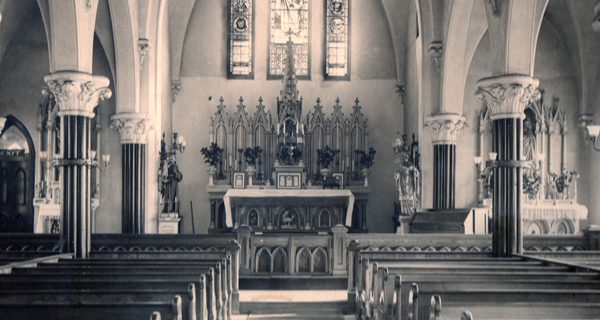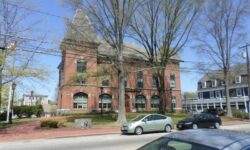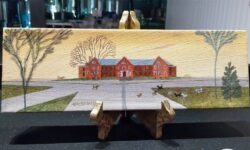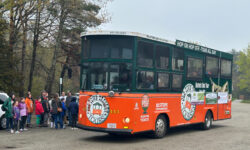[ccfic caption-text format="plaintext"]
By Richard DeSorgher
Hometown Weekly Correspondent
They were the pioneers; the first of the Irish to enter into Medfield, break the prejudice and live the “American Dream.”
James Griffin, born in Ireland, came to Medfield in 1840 at the age of 20 with his brother Michael. He found employment in the Balch Bakery, at the time located on Main Street opposite Brook Street. James married Ann Doyle and they began to raise a family here in Medfield.
By 1854 James and Ann were living on Main Street, in what today we know as the Peak House. James and Ann, strong advocates of their Catholic faith, invited the other 20 Catholics living in Medfield to their home, where Father O’Beirne of Tommy’s Rock Parish in Roxbury celebrated the very first Catholic Mass said in Medfield.
From then on up until the building of St. Edward Church in 1893, Catholic Masses were being said at the Clark Tavern, next door to the Peak House, Town Hall, Frost’s Block (16-20 North Street) and a number of private homes, including for an extended period at the John Sullivan home on 41 Pleasant Street.
With the outbreak of the Civil War, and at the age of 42, James enlisted into the 33rd Massachusetts Regiment, Company H, where he served as a corporal. Brother Michael enlisted at the same time and fought side by side with James until they were honorably discharged on June 11, 1865 at the end of the war.
In 1868 James and Ann gave birth to a son, Michael, named after James’ brother. It would be Michael who would unite the other Irish Pioneer Family in Medfield, the Sullivans. Young Michael married Katherine Sullivan, daughter of John and Elizabeth (Story) Sullivan. It was John and Elizabeth who opened their 41 Pleasant Street home for Catholic Masses and it was John who was instrumental in the building of St. Edward Church, then on Main Street, opposite Town Hall.
So instrumental were the Sullivan and Griffin families’ efforts in the building of a Catholic Church in Medfield in 1893 that the trowel used in the laying of the corner stone was given to John Sullivan. The three stained glass windows, above the altar of the wooden gothic style church, were gifts of the Sullivan family.
In addition to the Griffin family, other gifts of stain glass windows came from the other Irish Pioneer families with names of O’Rourke, Donlan, Callahan, Grace, Donnelly, McGory, Brennan, Meany, Hallohan, Ring, Kelley, Miller, Gilbert, Collins, Haney, Voss and Dugan.
When James Griffin died in 1896 he became the first Catholic to be buried in Medfield. Catholics were not allowed burial in Vine Lake Cemetery, the town’s only cemetery, until Town Meeting voted in 1895 to set apart forty cemetery lots adjoining Dale Street for the use of St. Edward Parish.
Before 1896 Medfield Catholics were buried in area Catholic cemeteries. The Griffin and Sullivan families became established and accepted in Medfield. The Griffins gained respectability from being Civil War veterans and after the war as being fellow Grand Army of the Republic (G.A.R.) members.
Both the Griffins and Sullivans began to acquire wealth and acted as banks, buying property, issuing mortgages, and loaning money to other Irish families, as many of the Irish faced real prejudice here in Medfield and throughout the country.
Young Michael soon began to make a name for himself in Medfield and became one of the town’s most respected citizens. In 1899 he was elected captain of the Edwin V. Mitchell Camp No. 131, Sons of Veterans. Michael became a volunteer with the Medfield Fire Company, serving as clerk.
In 1921 the Town of Medfield voted to establish an elected Board of Water commissioners, with Michael Griffin elected as one of the three members. That same year Medfield created its first Warrant Committee, again with Michael Griffin as one of the members appointed by the moderator.
By 1923, Medfield’s famed landmark, the Peak House, had deteriorated and was facing demolition by neglect. A grassroots effort led by the Medfield Historical Society tried to save the historical landmark. Griffin was one of the driving forces on the committee that resulted in saving the landmark and having it turned over the historical society.
Griffin was also a member of the school building and planning committee that brought about the building of the new Medfield High, today’s Pfaff Center, on the corner of North and Dale Streets.
Today, the Griffin and Sullivan graves sit side-by-side, high and proud, above the “Catholic” section of Vine Lake Cemetery. They were the Pioneers!
Richard DeSorgher is a Hometown Weekly Correspondent. To reach Richard, email news@hometownweekly.net.









